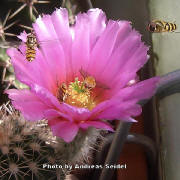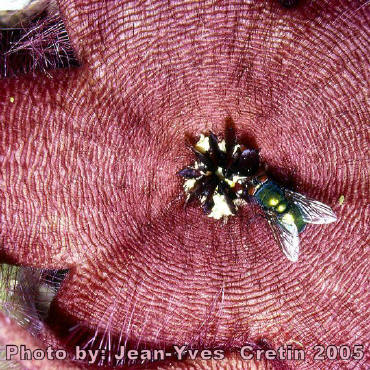| |
|
|
| |
Carrion-fly pollination
(Sapromyophily) is the
pollination
by carrion flies. |
|
Flies (Dipterans)
are among the most common
insects that visit
and pollinate
flowers. Flies have
been mentioned as
pollinators or regular visitors of thousands of species of
flowering
plant. A great variation of pollination methods is found among the
plants that are fly pollinated. Many of the pollinator flies feed on
exposed fluids and also eat small solid particles including
pollen grains. Flies
are important pollinators under certain climatic conditions because they
are present at all times of the year. Some plants may be completely
dependent on flies for pollination. Even flies that are generalists in
their floral visits can contribute to plant reproductive success, and
may equal or rival
bees as effective pollinators in some.
There are two types of fly pollination, myophily and
sapromyophily.
 |
 |
MYOPHILY (Fly pollination): In general,
typical fly pollinated flowers do not
bloom
regularly and are simple with very little depth. Flower colour is
usually pale with a dull texture.
Nectar guides
often occur. Nectar is open or easily available and the
male and
female parts of
the flower are
well exposed. Many of these flowers are scented, but for the most
part, the scent is imperceptible.
The "hoverflies" are some of the most common pollinators flies, they
are often brightly coloured they are also known as pollen eaters and
visit tubular or convex shaped flowers. Adult flies feed on pollen
and nectar.
(Plants that are fly pollinated include for example: Euphorbia,
Sedum and various members of the Crassulaceae, Brassicaceae
and Orchidaceae families) |
"Hover-Flies" or "Flower fly"
Scientific
name Syrphus balteatus one of the most common
species of the Syrphidae
family
(Diptera
order
).
Left: On a Crassula flower (Photo by: Andrea B -
Italy)
Right: On an Echinocereus reichembachii (photo by:
Andrea Seidel (Germany) |

▲Above: In this
corolla of Stapelia
grandiflora a female of "green-bottle fly" (Lucilia
sp.) comes to
ovideposit a new packet of eggs... note that a lot of eggs (the
white masses) were deposed before by another flies !
(photo by: Jean-Yves
Cretin (France) |
SAPROMYOPHILY
(Carrion-fly and dung-flies pollination): Certain flies are
deceived into pollinating flowers that produce odours of decay and
mimic
the decaying flesh in which these flies normally oviposit. Typical
carrion or dung-flies are uninterested in the flowers as such, but
go to the flower "expecting" to find rotting protein. Not finding
the rotting protein, they will leave; therefore, most sapromyphilous
flowers have traps to prevent the flies from rapidly leaving. The
traps are similar to those found in the insectivorous plants and can
be one-way bristles, slipways, or seesaw petals.
Characteristics
of sapromyophilic flowers include:
radial in shape,
often with great depth, or lantern shaped, frequently with window
openings through which the flies crawl into the blossom (or trap).
Flowers have a dull texture and are dark colours of brown, purple
and greenish. There are no
nectar guides
on the petals but often they are maculated (marked with dark
spots). Reproductive organs are generally hidden.
|
|